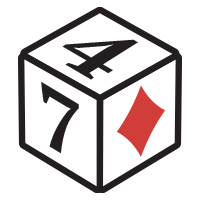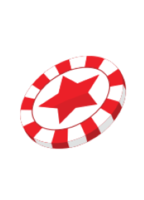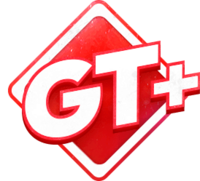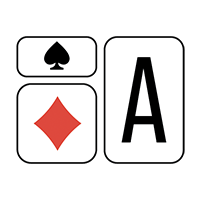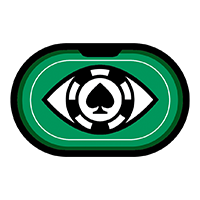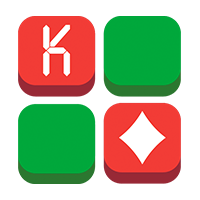Andrey check_behind started a blog on the forum called " This Casino's Mouth: From NL2 to NL50" . He analyzed a hand from NL10 in which he block-bet 10% of the pot on the river against a passive opponent. New GreenLine coach Vitya Largus commented on his analysis and explained why it is so important for micro-stakes players to analyze the hands they have played.
Vitya Largus :
I find such analyses extremely useful because they develop logic, and this is the key thing I would recommend working on at low stakes. This way we gain factual knowledge about the game, we begin to feel the boundaries of the ranges more accurately: this is a value bet – then we bet, and this is not – we check. We find great situations for bluffs. We study our range and the range of the opponent, our game becomes more accurate and tougher.
With experience and accumulated knowledge, we gain the ability to effectively distribute our range across different lines in order to realize our equity and, on the contrary, neutralize the opponent's equity.
I suggest approaching Hero's analysis as a research. That's the perspective I'll be commenting on it from. Not comparing Hero's play to solver frequencies and not arguing about sizings (in this particular hand, sizing may be the hardest part, and our job is to simplify the situation given the stakes being played).
The hand was played at the NL10 stakes, RedStar Poker, regular 6-max table.
Stats on opponent for 1k hands:
VPIP 25, PFR 20, 3-bet 8.5, F3B 39
Aggression on the streets: 36, 28, 23
Income to SD 23, winnings 53, WWSF 39
Vitya Largus :
Already at this stage, we begin to collect important information that will be useful in the hand. There are few hands on the opponent, but this is enough to understand his preferences. We are opposed by a typical tight representative of the stakes: average values on the preflop, aggression decreasing towards the river, general low aggression (very low WWSF). 1k hands is a sample in which the values can still be distorted, but, as a rule, we can already rely on them. At the same time, any numbers are the last thing that interests us: we will analyze texture and ranges first of all.
The table is falling apart, so we play 4-max.
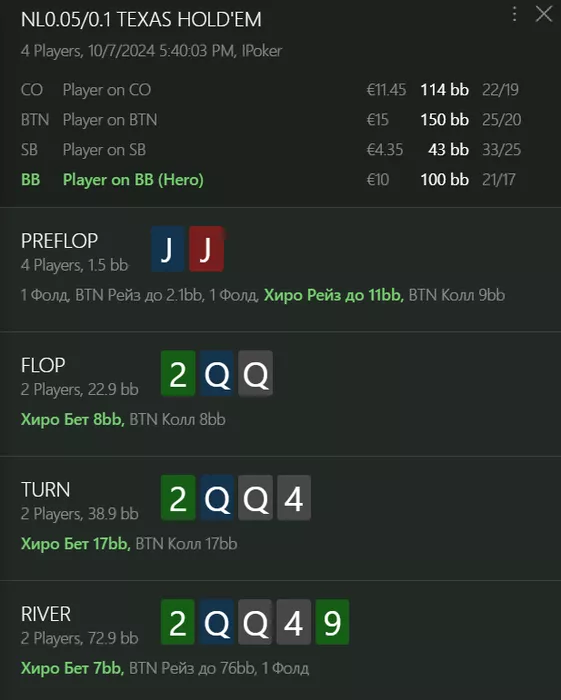
Preflop
Opponent opens from BTN, we 3-bet 5.5x from BB with JJ.
My BB vs BTN 3bet range looks like this:
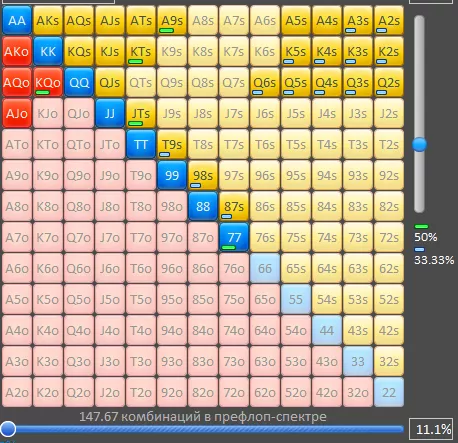
In general, I try to polarize 3-betting against raises from late positions.
Vitya Largus :
The idea of polar 3-betting from the BB is exactly what we need. It is not necessary to copy the solver strategy, spreading frequencies across different hands in the spirit of: 25% with this category of hands, 35% with that. It is enough to follow the concept of range building – 3-bet polarly. Hero correctly interprets this idea. I would suggest reducing the number of medium-strength hands, converting them to calls: A9s, KTs, QJs, AJo, 88, 77, and instead 3-bet low offsuit aces.
The sizing was chosen well.
The opponent calls, so I see his calling range:
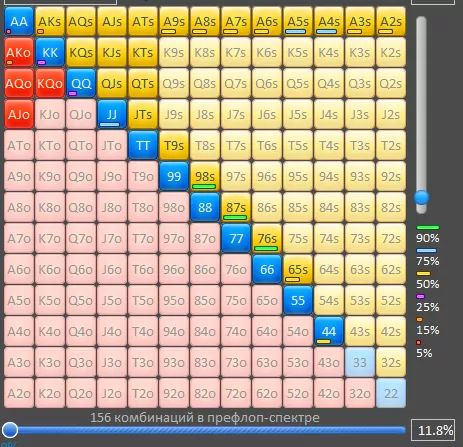
For the sake of purity of the experiment, I added some slow plays with premium hands that he decided not to 4-bet. I left some of the low and mid AXs hands that he did not fold or bluff 4-bet with. Judging by the fold to 3-bet stat (39), he doesn't really like to give up.
Vitya Largus :
Here I would also make adjustments, after all we need to get the most probable range. AK and QQ+ in these positions will be extremely rare in a call. I would also reduce the amount of JJ and slightly cut TT. Based on the tendencies of the field, I would add a few suited hands with a nine to the calling range: K9s, Q9s, J9s, and reduce the number of connectors. Some of the AJo and KQo will go into 4-bet.
Flop
This is a nice dry board for our second pair. Despite the overcard, our range has an equity advantage.
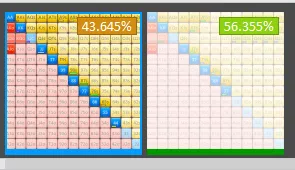
Specifically, our hand here has a comfortable default value bet + we need protection from the opponent's overcards. I bet a little more than a third of the pot, the opponent called.
Vitya Largus :
The most common sizing here will be half the pot. This is due to the sizing that is preferable for the middle part of our value range – high and medium pocket pairs. However, playing this texture with a high bet frequency with a small sizing will also be effective. A large sizing can also be used, but within the framework of our simplified strategy that we are building right now – it is rather unnecessary, an unnecessary complication.
The opponent has few overcards and with a pair of jacks we hardly feel this threat. But we want to value bet made hands and realize the equity of unmade hands – and it will be easier to do this from a bet, so I would exclude a check.
This is our equity against his entire range:

This is the equity against our bet calling range:

We can visualize how the opponent's range has changed:
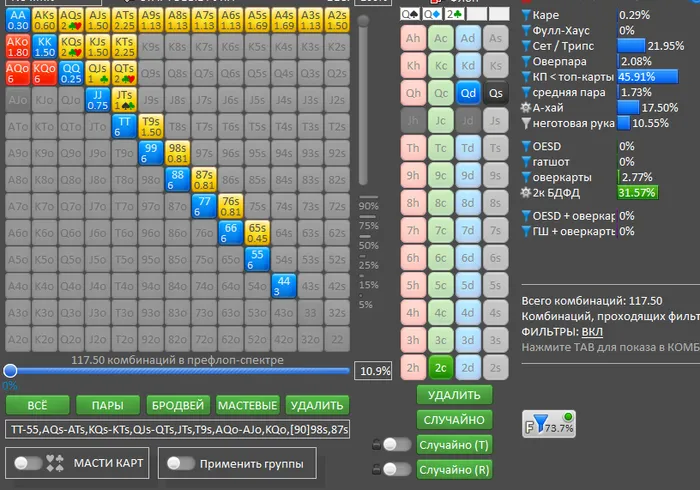
I don't think monsters (quads and trips) will raise in position here. I also left all pocket pairs, AK and backdoor flush draws (high ones with more weight, low ones with less).
Vitya Largus :
I agree that we will rarely get raises on such a texture, so we can forget about this line. Against a small bet, a significant number of opponent's AJo will go into defense, and backdoors like 87s will not be defended.
Turn
The four didn't really change the situation, except that the backdoors improved to flush draws. However, we still have a value bet. The main layer of hands that pay us are pocket pairs.
I bet about 43%, I think it was possible to increase it to half the bank. The opponent presses call. Let's look at his range:
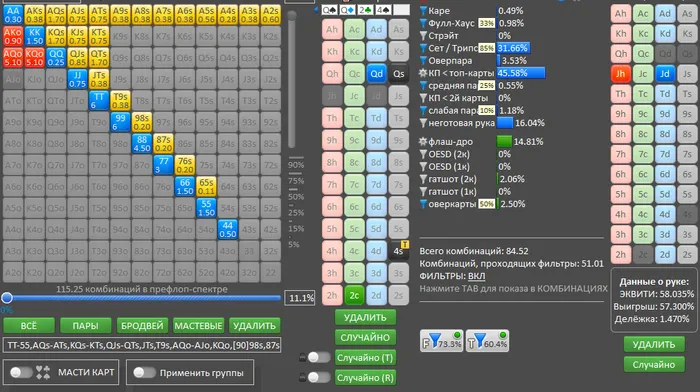
Phantom and invulnerable quads, unlikely full houses and overpairs always call, trips can rarely raise (after all, a flush draw is in + the pot needs to be accelerated). Some pocket pairs can already fold, but JJ, TT and 99 remain with full weight. Flush draws will also play a call (I noted that very low ones with weight can fold). I also left 50% of AK in the range.
Vitya Largus :
The picture on the turn is a little distorted due to the previous streets, but it is not critical. An imperfect analysis is always better than an analysis of an undone one, and with each iteration our vision of the game situation will become clearer.
To form a clearer picture (including the reaction of opponents) I would stay within the standard sizes. Half the pot or ¾ would be a good choice.
River
The 9c comes, covering nothing but pocket 99. SPR is less than one.
Here I thought about what action to choose. I don’t want to play check-call a big bet. I don’t want to bet big myself – as if weaker hands won’t pay. I chose to place a block-bet of 10% of the bank and make a decision in case of a raise. That’s basically what happened, we got a raise-push.
Let's see if we have enough equity to call. Taking into account the rake, there will be 188 bb in the pot. We need to call 56.8 bb, pot odds are ~30%. Obviously, if the opponent bets exclusively for value, then our hand has 0% equity.
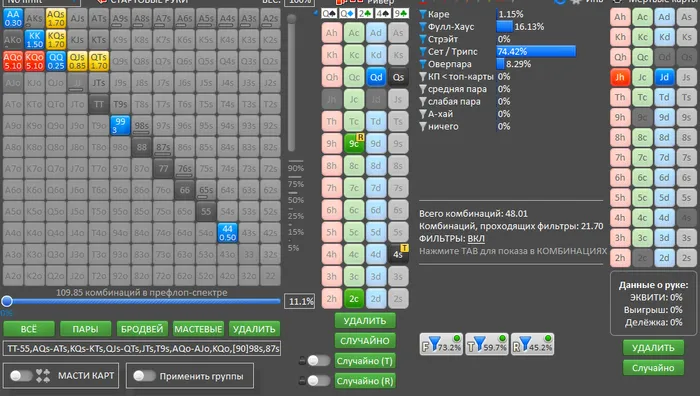
If we think he'll shove his missing flush draws, then calling won't work either.
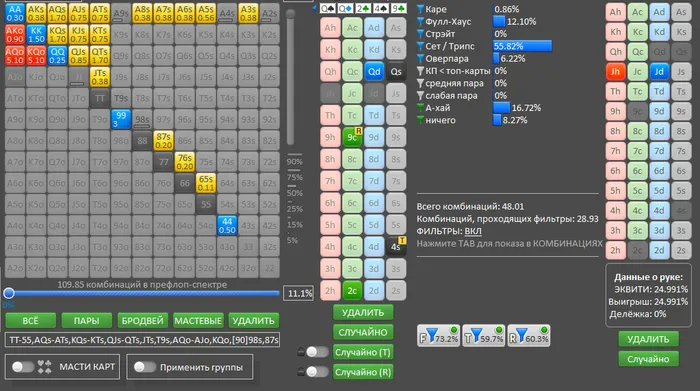
This means that in order to make a zero call, the opponent must turn his third pairs into a bluff at least once out of 4 times.
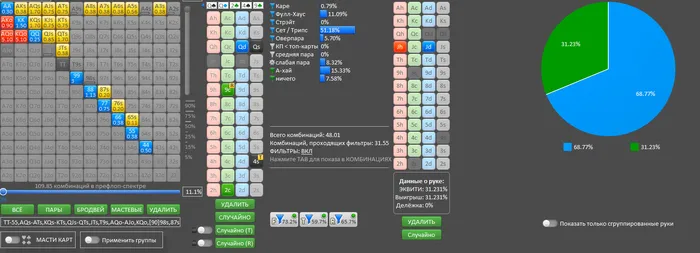
During the game I didn't count enough bluffs to call, so I folded. The opponent's hand will remain a mystery. The decisive factor here was the aggression indicator – the sample is not representative enough for the river, but based on the trends on the flop and turn, it seemed to me that the opponent would not have enough bluffs.
Vitya Largus :
And now we come to the most important part of the analysis. Hero analyzes the decision on the river, but should we even be in this situation with this hand? I do not dispute the author's decision, but I suggest we reflect: did we really choose the most profitable, effective and understandable line for ourselves?
Let's get back to the beginning of the analysis. So, our task is to simplify the situation as much as possible (we can always complicate it), "feel" the equity of our different hands in relation to the opponent's range. The path of simplification involves a limited set of sizings – and this is exactly the path we will take. Paired textures are specific in terms of sizing, I suggest choosing one set of sizings for flop + turn and playing the entire range within its framework. This can be ½ + ½ or ⅓ + ¾.
It's best to start any analysis with the right question. For example, in its broadest form, it could be "How do I play my range on this texture?" Answers to difficult questions start with answers to simpler questions, I suggest starting with defining the boundaries of equity: "With what hand can I triple barrel for value?"
In this case, against most opponents, the bottom of three value barrels (playing for stacks) will be trips. A significant part of our range is made single-pair hands, the equity of which is enough for 1-2 bets. We have to check with them somewhere. We have the initiative, the average opponent at these stakes is rather passive (especially a specific opponent, as we found out at the beginning), so we will look for lines from the bet. In solving this problem, I suggest starting from the "hand value" – our approximate idea of how many streets of value we have from the flop. And for what sizing.
Hero's analysis showed that his hand is worthy of two value bets. So the two-bet branch is suitable. The only decision left is on the river. The solver will suggest pushing the river with the same pairs, but the problem with real play is that the opponent's call will be much tighter than the machine's. For this reason, it is better to play off pairs from two bets, and take trips and the best bluffs into three barrels.
Hero's river decision is atypical, but the reasons for it are clear. We need to think: aren't we creating additional difficulties for ourselves by using such a block bet? Do we accurately understand the opponent's reaction? Is it a problem that for a thinking opponent our range here is transparent if we do not protect it in any way? Will we provoke even a tight opponent to aggression?
If these questions are difficult, I would suggest checking the river. If we think we are short on the ⅓+½ line, we can tighten up the turn sizing and use the ⅓+¾ connection. This way we have played the hand for its price and saved ourselves from complications on the river. On our line against an average opponent, this will be an easy check-pass.
A good way to finish the analysis is to move from the specific to the general: look at your range as a whole. Think about how it can be played out in two or three bets, not only with value, but also with bluffs.
A good three-bet bluff in this situation can be hands that block trips for our opponent, such as AK or KJ (we block the most likely trips from the opponent's range plus rarely win at showdown on the bet-bet-check line). Are there any good bluffs for two streets? How much fold equity do we generate on the turn and how does this relate to the chosen sizing? At this stage, we can find cool exploits of the field if we understand its reactions well.
Finally, we fix the hands that are only good enough for one street, plus we supplement this category with single-barrel bluffs from among the weakest hands. Think for yourself what sizing would be preferable here.
Do you feel your growing greatness after the work you have done? You are magnificent!
- Increased first deposit bonus
- Increased rakeback and reloads
- Help with deposits and cashouts
- Access to private freerolls
- Round-the-clock support
